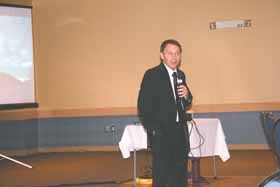The weather is always a topic of conversation for farmers.
So there was a good turn out last Wednesday to hear Kansas-based meteorologist Drew Lerner talk about the topic at the Farrell Agencies Farmer Appreciation Night held as part of Grain Millers Harvest Showdown in the city.
Lerner, who has focused on weather data for farmers the past 35-years, said he appreciated weather has been a bit extreme recently.
"You guys have certainly been challenged the last few years," he offered, adding from the patterns he has seen, " maybe next year will be a little better for you."
Lerner said while recent trends in eastern Saskatchewan have been the wettest since the 1950s, even in that wet decade there was a drier year or two, adding "we're due for one of those."
The trend toward drier is already present in Alberta where overall moisture levels trend drier.
"They've gotten timely rains, while we've got soakers out here," he said.
But what is ahead?
Lerner said to predict what is to come he has looked at a number of sources of insight.
The first are 18-year cycles of wind patterns which are "aloft, not here at the surface." The general pattern generally repeats on an 18-year pattern, and the pattern suggest less precipitation and colder temperatures ahead, through January to March.
"The bias of the 18-year cycle is colder, especially in Eastern Canada," he said.
But there are other factors at play, including the El Nino phenomenon in the Pacific Ocean.
While some were calling for a 'super El Nino', Lerner said that has not yet occurred, but there are still "El Nino-like" influences at play.
An "El Nino, always, always, produces a drought in Australia," he said, adding farther from the centre of the effect an El Nino effect in Western Canada has a "drier bias, and a warmer one too."
That said, he added "we're not going into a full blown El Nino, most likely."
Lerner also looks to Arctic Oscillation as "a very important pattern for us in Western Canada," in terms of upcoming weather. Based on AO alone it would suggest colder, as current patterns reflect those of 1950 which was both cold and had lots of snow.
However, the effect of the AO will likely be tempered by the 18-year upper level winds, said Lerner.
As a result of the differing influences in the months ahead, Lerner suggested some volatility.
"We'll see our temperatures bounce around quite a bit," he said. He added for Yorkton there could also be "a drier bias."
Even with a bit drier winter, Lerner said water will be an issue in spring since we head into freeze up with a high water table.
"We're really going to need a warm spring," he said, in order to dry conditions for seeding.
Once through spring having El Nino like conditions could "lead to a drier bias in the summer season," offered Lerner.



